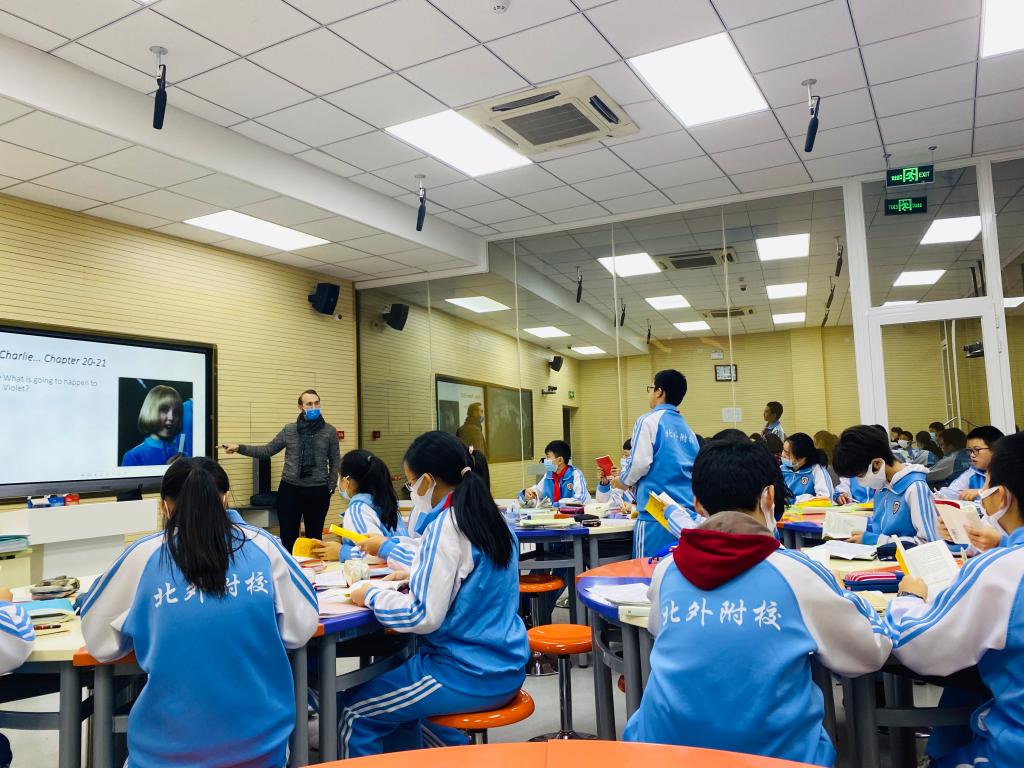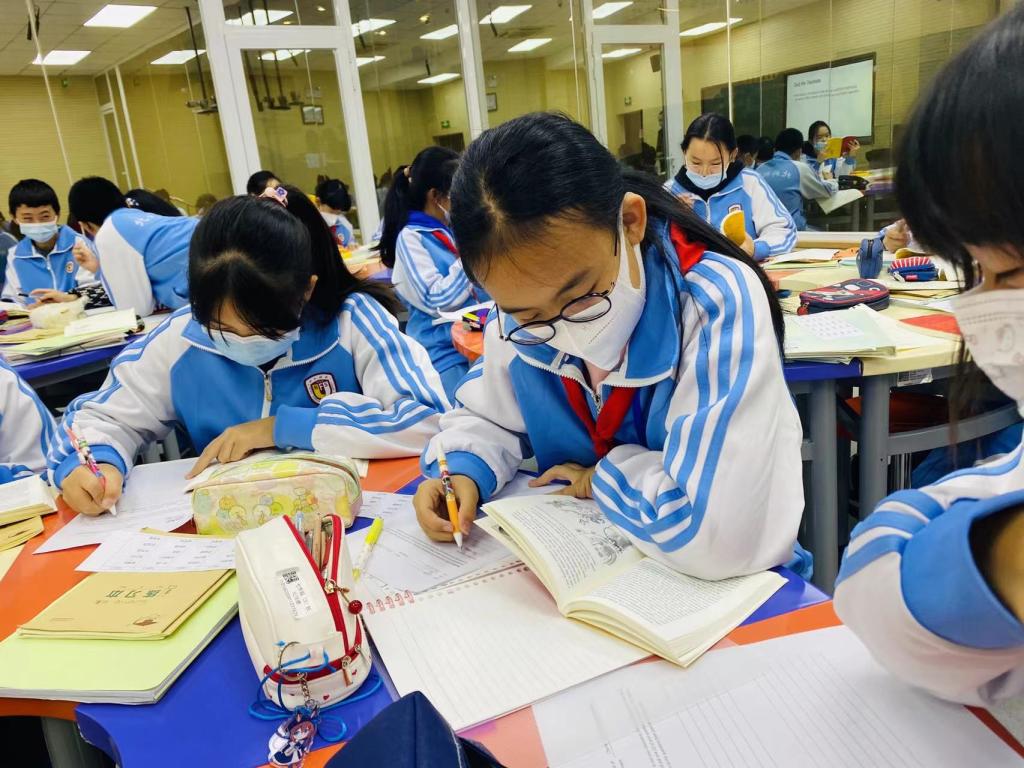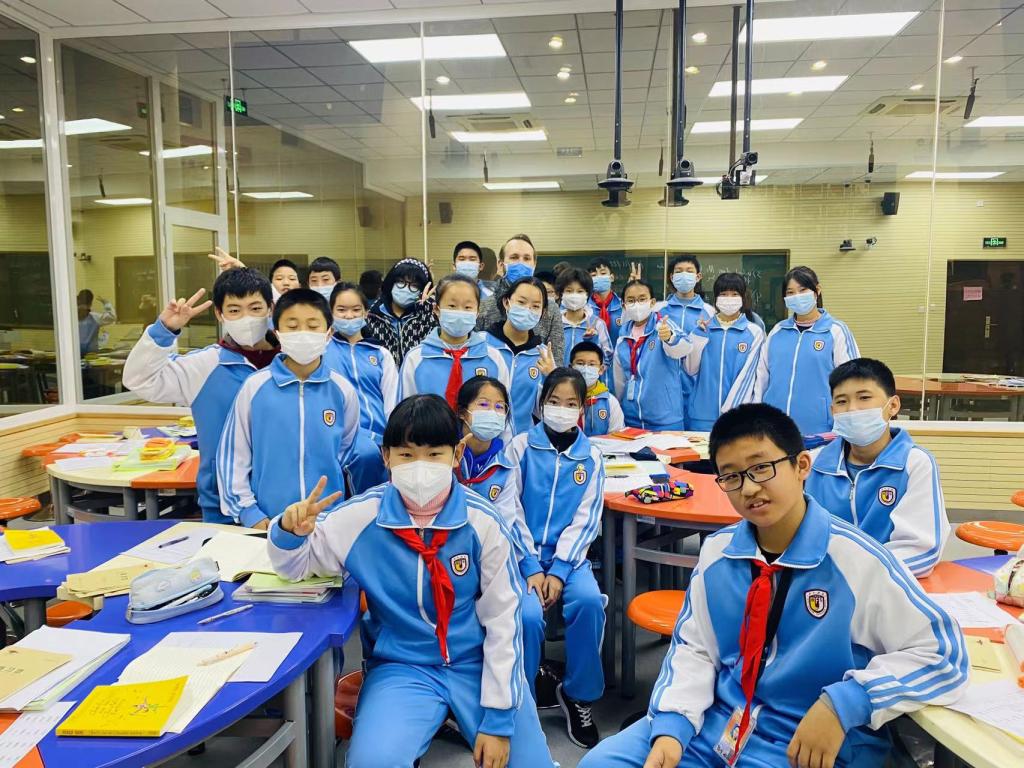11月22日,初中英语高端英语项目组初一外教Mr. Simon为学生们带来了一次奇妙的阅读之旅。有趣的内容,生动的教学,把小说“查理与巧克力工厂”以独特的方式呈现给学生,让学生在阅读中体验英语学习的乐趣。全体高端英语项目中外籍教师观摩听课并评课。

Mr. Simon首先利用小说中的Violet这一角色图片引导学生预测可能会发生在这个小女孩身上的故事。发散并打开学生的思维,把学生的注意力引到本节课即将开启的故事情节中。学生们通过形象的图片很快展开了自己的想象。在引发学生的好奇心后,教师开始本章节的词汇教学。Mr. Simon为每个新词都精心设计了生动的图片和动画来帮助学生理解,并配合例句来构建单词的使用意义,使学生不仅学到了很多新词汇并且也激发了他们表达的欲望,有趣的词汇学习让学生们欢笑声不断。

扫除词汇障碍后接下来就开启了真正的阅读之旅。Mr. Simon设计了层层递进的阅读任务,从略读、泛读到精读,再到学生自己讨论,一步步引导学生走进故事情节中,并培养学生的阅读微技能。值得一提的是,Mr. Simon利用自己精心设计的学案让学生带着问题去阅读并通过在屏幕上用不同颜色字体标注的方式带着学生一起阅读加深理解,学生在这个过程中也学会了如何书上标注笔记。过程中Mr. Simon不断关注每位同学的完成情况。


最后,Mr. Simon在读后环节中让学生在小组内自由提问并解答小伙伴的问题,每个小组都展开了热烈的讨论,大家积极分享着自己的问题和答案并在班级展示。从同学们的展示中可以看出他们在阅读中的收获满满。

课后所有听课老师们对Mr. Simon这节课展开了教研讨论,大家积极提出了自己宝贵的意见,充分肯定了Mr. Simon对小说阅读课的精巧设计。同时本次外教公开课为我校中外籍教师提供了一次宝贵的阅读课交流契机并加深了彼此的交流。
附:外教Mr. Simon公开课反思
Reflection on Open Class
Content: Charlie and the Chocolate Factory, Chapter 20
For my open class, I covered chapter 20 from Charlie and the Chocolate Factory with my class. At the start we went over what ‘will happen’ to Violet (a character from the book) and then what ‘is happening’ to Violet (showing pictures of the character from the 2005 movie version). After priming them of the content, we went into the vocabulary (see ppt and/ or lesson plan for the words) that they will notice in the chapter. We first viewed how to use these new words then stated the new words in sentences, then learned the meanings. The students, as always are encouraged to write down the new words in the vocabulary notebooks and we would then review and use them in the writing class. After going over the vocabulary, we covered how to take notes (i.e., to annotate) and how to highlight and underline important information in the text. Then we dove into the ‘scanning’ questions to focus their reading for key points of the chapter and understanding the ‘order of happenings’ (the skill that was focused for the class). We would read one or a couple questions then read a section the chapter to find the answers then read one or a couple more questions and repeat. After we were done reading, I asked the students to work with their ‘table-mates’ to come up with questions from the chapter to ‘quiz’ their other classmates. I wrote the questions each table came up with and the table that was able to answer these questions earned points for something special.
Overall, I thought it was a relative successful class. The students did seem to enjoy the class, while being engaged and the subject matter not being too easy nor too difficult. There were some issues I did notice in my own ppt, either I over-looked these errors or copied the wrong ppt. However, I would defiantly make sure that ALL the vocabulary words would be underlined ALL the time (found some vocabulary words, for whatever reason, not underlined in the ppt). Also, I realized that with some students I needed to be CLEARER or repeat that the ‘quiz questions’ needed to be from the chapter we read and not from other parts of the book, but did deal with those particular issues quickly as they popped up. This class lesson would defiantly be more successful if broken up more, due to only having 40 minutes. Either read half of the chapter one day and the other half the next while still going over the scanning-questions and possibly having a ‘mid-chapter’ formative assessment (the ‘quizzing the classmates’ activity was a formative assessment as well as an activity to engage their inquiry skills) or some other way.
Regardless, I believe the students are now getting more familiar with not only how we in English order cause and effect in a passage/ paragraph, but are getting more familiar with the words that ‘transition’ to each ‘happening.’ This will be more focused later, specifically in the writing course. They also took away more English vocabulary words to use; therefore, I again believe the course was a relative success.
在我的公开课上,我和同学们一起学习了《查理和巧克力工厂》的第20章。一开始,我们讨论了维奥莱特(书中的一个角色)将会发生什么,然后讨论了维奥莱特将会发生什么(展示了2005年电影版中的角色照片)。给他们讲解完内容后,我们进入他们会在本章中注意到的词汇学习中(单词见ppt和/或教案)。我们首先观察如何使用这些新单词,然后在句子中陈述新单词,然后学习意思。学生们一如既往地被鼓励在词汇笔记本上写下新单词,然后我们会在写作课上复习和使用它们。在复习了词汇之后,我们学习了如何做笔记(也就是注释)以及如何突出和强调文本中的重要信息。然后,我们进入“扫描”问题,让他们集中阅读本章的要点,并理解“发生的顺序”(这是课堂上的重点技能)。我们会读一个或几个问题,然后读本章的一个部分来找到答案,然后再读一个或几个问题,然后重复。在我们读完之后,我让学生和他们的“同桌”一起想出本章的问题来“测试”他们的其他同学。我写下了同学们提出的问题,能回答这些问题的小组赢得了分数。
总的来说,我认为这是一堂相对成功的课。学生们似乎确实很喜欢这门课,因为他们很投入,而且这门课设计难度适中。此外,我意识到,对一些学生来说,我语言需要更清晰一些,但是当某些特定的问题出现时,我会很快处理它们。由于只有40分钟的时间,如果能用更多的时间,这节课会更成功。 (对同学的“测验”活动是一种形成性评估,也是一种激发他们探究技能的活动)。总之,我相信学生们现在不仅越来越熟悉我们在英语中如何排列一个段落的因果关系,也越来越熟悉段落结构,之后我们会有更多类似的练习,特别是在写作课程中。他们也学到了更多的英语词汇。因此,我再次相信这门课程是相对成功的。